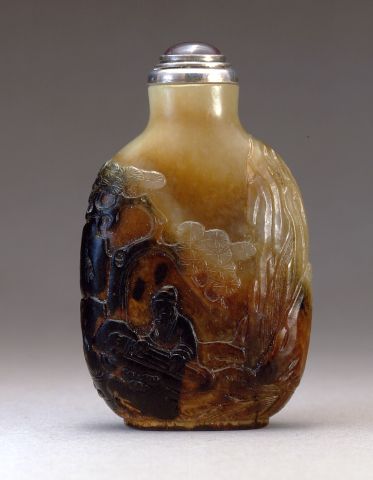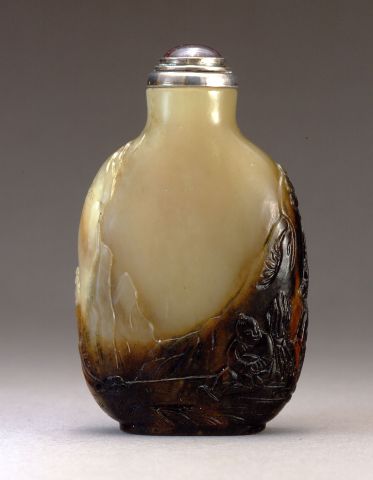

Bottle ID: 307
LANDSCAPE, MASTER OF THE ROCKS
Date: 1750-1850
Height: 64 mm
Nephrite, yellowish-green with black and brown skin, of well-hollowed, flattened rectangular form with sloping shoulders and a neatly carved footrim, carved in low relief with a continuous scene of a scholar, seated beneath a pine tree in a rocky landscape, playing the gugin on a natural rock table while a wood-cutter sits listening nearby, beside a rock bridge across a stream, his bundle of wood beside him.
Master of the Rocks School.
Similar Examples:
Crane Collection no. 447
Moss, Hugh, Victor Graham and Ka Bo Tsang. A Treasury of Chinese Snuff Bottles - The Mary and George Bloch Collection, 1995, Vol. 1, pp. 350-353, no. 136.
Stevens, Bob C. The Collector's Book of Snuff Bottles, 1976, pp. 118-119, no. 410.
Sotheby's, Hong Kong, October 30, 2000, lot 621, The Guo'an Collection.
Provenance:
Hugh Moss [HK] Ltd.
Eric Holleman
Hugh M. Moss Ltd.
Christie's, New York, October 18, 1993, lot 50
The Reif Collection
Exhibited:
Annual Convention ICSBS New York, November 2013
This bottle is one of the masterpieces from a school of carving once known, based upon a misunderstanding of the term, as the ‘Han school’. More recently, the school has been more appropriately called 'the Master of the Rocks' School, for its superb and distinctive carving of mountainous landscapes. Although the style differs, the school, at its best, is every bit the equal of the better known and more popular Suzhou School in terms of technical quality, artistry and in the impressive use of the natural markings in the material. This bottle epitomizes the subtle, yet brilliant use, of the natural coloring in the stone, although it is possible that the highly unusual black surface on the brown skin may have been enhanced by staining. The staining of nephrite was an option for the jade carver well before the Song dynasty and became a standard part of the decorative repertoire of the Qing jade carver. The Qianlong Emperor in particular had a penchant for archaism and instructed his workshops to stain jade to match ancient vessels. If the darker markings here are stained, they have been used to great effect to enhance the natural black markings in the brown skin and accentuate the main subject. Staining is not a common technique used by the school, but is apparent on a few other known examples.
< Back to full list

 English
English 中文
中文